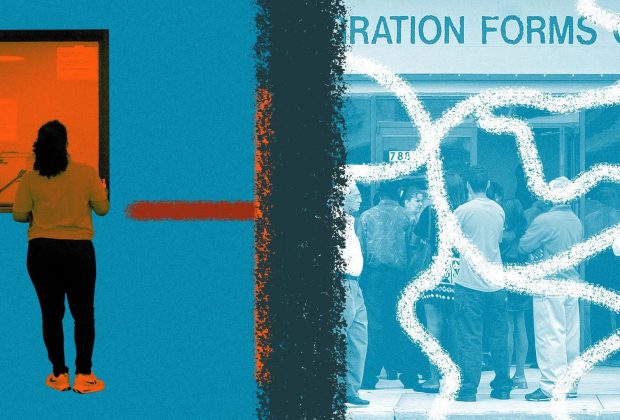By Russell Contreras | AXIOS | APR. 6, 2023 | Photo by Irfan Khan & Rhona Wise
Permanently moving to the U.S. was once as easy as getting on a ship or strolling across a border.
Today, most lawful means of entering the country take years because of overwhelmed immigration agencies, rising levels of global migration and a limit on the number of certain visas, all of which have culminated in a massive backlog of people trying to get to the U.S.
- Around 9 million people are awaiting green cards, and those wait times have skyrocketed from just a few months to years, possibly decades, according to the Cato Institute and other researchers.
- In 1991, only 3% of preference immigrants, or those seeking visas through family members already in the U.S., had to wait more than 10 years. By 2018, 27% of applicants experienced that wait time.
What the legal immigration system looks like now
The U.S. hasn't increased the number of certain visas it grants each year since 1990, when President George H.W. Bush signed an immigration bill that set quotas based on the country's population and labor and economic needs at the time.
- Since then, parts of Africa, Central America, the Caribbean and the Middle East have seen economic and political turmoil, forcing millions to flee to the U.S. and Europe.
- Agencies have become overwhelmed. The U.S. immigration system has a backlog of more than one million cases.
- The system for applying to enter the U.S. is also convoluted and difficult to navigate, advocates say. There are three major categories for visas: family-based; employment-based and diversity, although the government only allows 50,000 visas for the latter — and millions of people apply each year.
- There are also routes that allow people to temporarily live and and work in the U.S.
How past leaders have tackled immigration
Every U.S. president in recent history has stepped up enforcement of immigration laws and escalated deportations — but none has been able to successfully overhaul what politicians and advocates alike say is a broken immigration system.
- Democratic President Clinton authorized the construction of fortified border barriers at the U.S.-Mexico border and the expansion of the U.S. Border Patrol. Thousands of migrants seeking alternate routes died crossing through the scorching Arizona desert.
- Republican George W. Bush tried to push comprehensive immigration reform but was blocked by House Republicans and Democrats.
- Immigration advocates dubbed President Barack Obama "deporter-in-chief" for his administration's policies on unauthorized migration, which advocates said were aggressive and resulted in families being separated.
- The list of anti-immigrant measures introduced or implemented under President Trump is long, and President Biden has made his own moves to slow illegal migration.
What migrating to the U.S. looked like in the past
Before World War I, the U.S. didn't have its current visa system and effectively had open borders, David J. Bier, associate director of immigration studies at the Cato Institute, tells Axios.
- Europeans only had to board a ship to the U.S. since there was no American consulate to apply for a visa. They would be processed for entry at Ellis Island.
- The late University of Houston law professor Michael A. Olivas, an immigration law expert, repeated many times that prior to 1910 there was "no such thing as an undocumented immigrant."
Yes, but: The U.S. still prevented some migrants from entering the country or discriminated against them during waves of public anti-immigrant sentiment.
- Under the 1882 Chinese Exclusion Act, Chinese workers were banned from coming to the United States for a decade. The act was in place in one form or another until 1943.
- To determine the "mental fitness" of new arrivals, authorities administered an exam involving a wooden 10-piece puzzle known as the Feature Profile Test. According to the Smithsonian, officials said the exam would help keep out "feeble-minded" immigrants.
- "During the Mexican Revolution from 1910-1920, the U.S. forced Mexican migrants to strip and sprayed them with pesticides in response to racist claims that they "carried diseases and lice."
But, but, but: The Immigration and Nationality Act of 1965, signed by President Lyndon Johnson, is credited with lifting racist restrictions for people from traditionally non-white counties.
- But it also introduced the first set of quotas — limits to the number of prospective immigrants who could be admitted annually — for Latin America, Bier said.
This story is part of a series in Axios Latino focused on immigration to the United States.







